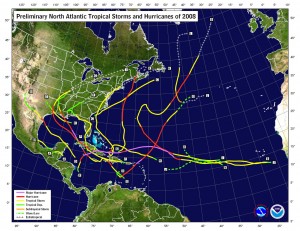
The hurricane forecasting team at Colorado State University released an updated forecast for the 2010 season and they continue to predict an above normal level of activity. The numbers would seem to put residents along the Atlantic and Gulf Coasts on notice that they should be prepared.
The CSU team’s forecast, generated by Dr. Phil Klotzbach and Dr. Bill Gray, portend what may be an active season in the Atlantic basin.
The team is calling for 15 named storms, 8 hurricanes and 4 major hurricanes (Category 3 or higher). By contrast, an average season has only 10 named storms, 6 hurricanes and 3 major hurricanes.
Residents in coastal regions will want to take note that the forecasters said there is a 69% probability of a major hurricane striking the United States coastline. That is 17% above the average for the past century.
Breaking their analysis down further, Klotzbach and Gray forecast a 45% chance of a major hurricane striking the U.S. East Coast and a 44% chance of one striking the Gulf Coast. For the Caribbean, a 58% chance of a major hurricane tracking through the area is given. Each of those reflects significant increases above average.
This year the team says weakening El Nino conditions coupled with warmer water in the Atlantic will account for considerably above normal activity. The 2009 hurricane season fell flat and finished with the fewest number of storms since 1997 and was one of the least active on record.
AccuWeather.com’s hurricane forecasting team led by Joe Bastardi issued their forecast last month and predicted an ‘extreme season.’ Their forecast called for 16 to 18 named storms with two to three with five hurricanes making landfall, two to three of those being major hurricanes.
Hurricane season officially starts on June 1st and runs through November 30th. However, hurricanes can and have formed anytime between March and December.
For more on hurricanes, check out these other stories from the Natural Disasters Examiner:

